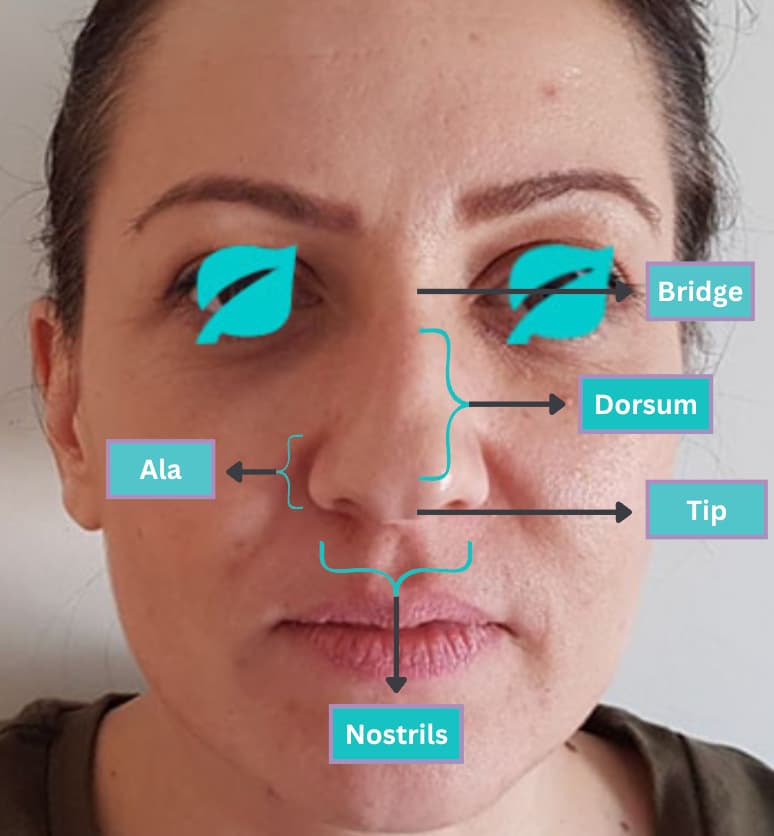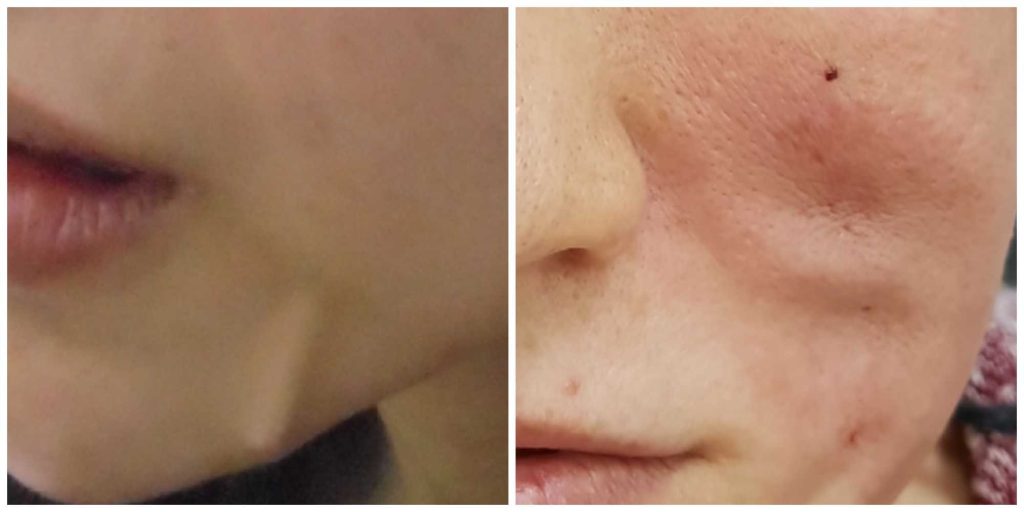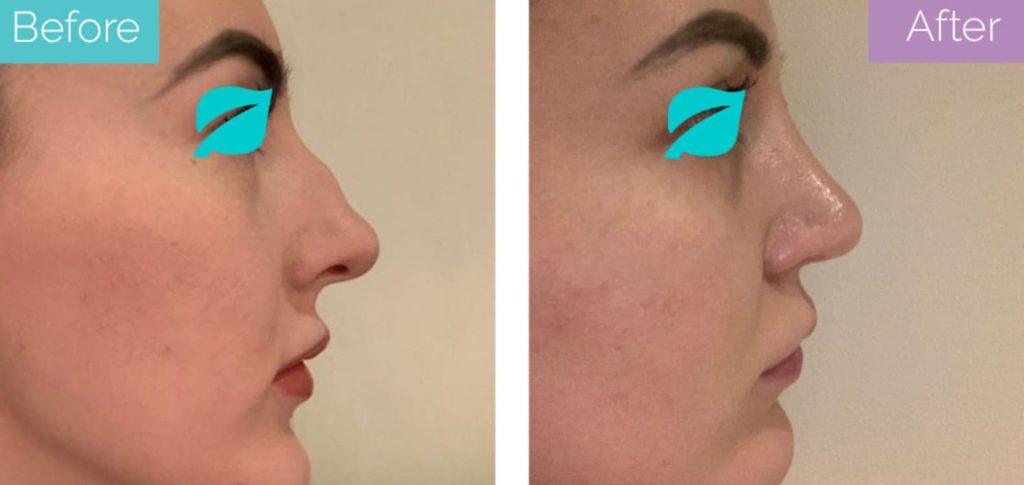Nose thread lifts are marketed as safe, non-surgical alternatives to surgical rhinoplasty. Over the years, this treatment has become quite popular due to the promise of zero downtime and quick results.
However, nose thread lifts – like other threading procedures – remain controversial in the medical community. Many practitioners are unwilling to perform them because their risks outweigh any potential benefits.
Therefore, if you’re also considering this procedure, you should understand exactly what you’re getting into. You can then decide whether it is worth the risk.
What Is A Nose Thread Lift?
A nose thread lift is a type of procedure in which barbed polydioxanone (PDO) threads are used to subtly change the contour of the nose.
The barbed structure allows for the threads to entangle with the tissue fibres. That, in turn, makes it possible for them to stay in place.
Keep in mind that nose thread lift is a non-surgical procedure. However, it’s not exactly “non-invasive” because a cannula is used for inserting the threads inside the nose.
Additionally, this treatment is not permanent since the PDO threads are eventually hydrolysed by the body.
But these are inserted in different parts of the nose – mainly the tip and dorsum – to lift it and change its appearance and projection.
For further cosmetic improvement, a nose thread lift may also be combined with fat grafting or nose fillers.
Who Is A Good Candidate For Nose Thread Lift?
You may be a good candidate for a nose thread lift if you want to:
- Make your nose look slightly slimmer.
- Lift the tip of your nose.
- Straighten your nose.
- Augment your nasal dorsum.
- Lift the nasal bridge.

Additionally, younger skin with no sun damage is more suitable for this procedure. That’s because it will have more strength to keep the threads in place.
Also, with older skin, changes in nose contour can be attributed to ageing and the effects of gravity. And these cannot be satisfactorily addressed by PDO threads.
Other than that, to have this procedure, you must have realistic goals and expectations.
A thread lift won’t change the underlying structure of your nose. It will only shift the position of the tissues, which will make the nose look different.
So, for instance, if you have a prominent hump or bump on your nose, a thread lift cannot “shave” it or make it smaller. You can get better results with fillers or surgical rhinoplasty.
How To Prepare For A Nose Thread Lift?
Before getting a nose threading procedure, your doctor will likely advise you to stop smoking and drinking alcohol. Additionally, you might be advised against any blood thinners.
Before coming to the clinic, you should make sure that your face is clean (no makeup). And it’s also a good idea to wear loose clothing so that it doesn’t press on your nose.
How Does Nose Thread Lift Work?
Your practitioner will begin by applying a topical anaesthetic to your nose 20 minutes before your surgery.
Once it has taken effect, they will begin by puncturing an “entry point” into your skin to place the cannula. Inside the cannula, the PDO thread is placed.
And the multidirectional barbed thread hooks into the skin once the cannula is removed. And excess edges of the thread are cut off.
The lifting effect of the threads will be immediate. And this entire process will be completed in around an hour.
How Many Threads Are Needed For A Nose Lift?
It depends on the number of areas on the nose that need to be addressed. Usually, practitioners use 3-5 threads per area.
So, for instance, if you’re getting the tip of your nose lifted, you’ll need 3-5 threads for the dorsum and around the same for the lower part of your nose. In total, it will take about 6-10 PDO threads.
Keep in mind, however, that their number can vary if you’re also supplementing thread lift with another nose treatment. It will also depend on the quality of your skin and your desired nose shape.
A total of 3 to 5 barbed PDO threads were inserted into the nasal dorsum.
Does Nose Thread Lift Hurt?
You won’t feel any pain during the nose thread lift because of the topical anaesthesia.
However, after it wears off, you’re likely to feel pain and discomfort. Therefore, you might be prescribed a painkiller for its management.
How Long Does Nose Thread Lift Take To Heal?
Despite the claims that a nose thread lift has no recovery or downtime, it will take 2 weeks before you can resume your normal activities.
It can cause some temporary side effects, such as:
- Swelling
- Pain
- Bruising
- Feeling of tightness
These can last from a few days to a month. And while you’re recovering, you’ll likely be given some aftercare instructions as well.
These can include:
- Not applying makeup.
- Not touching your nose.
- Not wearing any glasses.
- Icing (not directly) the nose for swelling.
- Avoiding sleeping on the face.
- Avoiding strenuous activities.
Make sure to ask about these from your doctor so you can recover normally.
How Long Does Nose Thread Lift Last?
PDO threads are hydrolysed (breakdown by water) by the body in about 6 months. Therefore, the results of a nose thread lift will last for less than a year.
Sometimes, however, patients retain the threads in their noses for years. According to a review published in the Clinical and Experimental Otorhinolaryngology (CEO), there can be different explanations for this.
For one, thick threads don’t dissolve as easily. Secondly, if you had a filler with your thread lift, that could interfere with the hydrolysis of the PDO. Or it’s possible that your practitioner used a non-absorbable thread.
But if it has dissolved, you can get another thread lift procedure.
What Are The Potential Nose Thread Lift Complications?
The possible complications of a nose thread lift include:
- Skin dimpling and indentations
- Puckering
- Granuloma
- Hematoma
- Thread extrusion
- Palpable threads
- Visible threads
- Infection
- Necrosis
- Nerve damage
- Scarring
- Allergic reaction
- Irregular nose contour
- Damaged cartilage

All these can cause permanent, irreversible damage to your nose. And reconstruction may not always be possible.
Is A Nose Thread Lift Worth It?
Whether or not a nose thread lift is worth it depends on your goals and expectations. If you’re looking to make subtle changes to the projection or angling of your nose, a nose thread lift might help you.
However, you need to keep its associated risks in mind and remember that the results are temporary. While usually one treatment session is required, some people also require more.
If you want to dramatically change the shape of your nose or fix any functional problem like a deviated septum, you’ll have to undergo septorhinoplasty surgery.
Can Nose Thread Lifts Go Wrong?
If your practitioner isn’t experienced, they can damage your nose while trying to insert PDO threads in them.
They can end up damaging a blood vessel, which can reduce the blood flow to a particular area of the skin. As a result, it can start to necrose.
Additionally, if the thread is not placed at the right depth, it will increase the risk of extrusion. You’ll see the thread poke out from the skin of your nose.
You can also develop serious complications (like the ones mentioned above).
What To Do If Your Nose Thread Lift Has Gone Wrong?
If you aren’t recovering normally, you should get in touch with your doctor immediately. They might do an ultrasound to check what’s happening underneath the skin.
In case of an infection, you’ll need to start a course of antibiotics.
Keep in mind that you don’t need to wait for your threads to dissolve. It’s possible to remove, although it can be quite challenging.
In the study published in CEO, researchers found that in trying to remove threads from the nose, the structure of the nose can be compromised.
Additionally, it can result in loss of tissue. However, restoration was made possible through the insertion of grafts.
Still, thread removal can cause a lot of skin problems, which can make future cosmetic rhinoplasty more difficult.
Is A Nose Thread Lift Safe?
A nose thread lift can be safe if done by an experienced, board-certified doctor. Still, this procedure carries many risks, which is why many practitioners choose not to offer it.
In any case, it’s extremely important that you find a good practitioner. That’s because even though PDO threads are eventually absorbed, a nose thread lift isn’t a reversible procedure.
How Much Is A Nose Thread Lift?
In the UK, you can get a nose thread lift for around £1,000. Since it’s a cosmetic procedure, you’ll have to get it privately.
Keep in mind that consultation, medication, and aftercare can cost you extra. The number of sessions required may also influence the total cost of the package.
Additionally, if you plan to maintain the results of a nose thread lift over time, you’ll need to take into account the long-term expenses.
Which Is Better: Nose Thread Lift, Nose Filler or Rhinoplasty?
It will depend on how you wish to change your nose, as well as its current condition.
If you want to slightly lift your nose, a thread lift can help. However, if you want to address volume loss or hide any bumps, fillers (liquid rhinoplasty) can help you.
But if you want to make dramatic changes to your nose permanently, a surgical rhinoplasty will best meet your needs.

Keep in mind that threads and fillers are only temporary, so you’ll need repeated sessions to maintain the results.
Here’s a summary of the differences between the three treatments:
| Thread Rhinoplasty | Liquid Rhinoplasty | Surgical Rhinoplasty | |
| Procedure | Barbed threads are placed inside the nose through a cannula | Dermal filler is injected into the nose | Bone and/or cartilage is removed or reshaped by cutting into the skin of the nose |
| Good Candidates | Young with the intention to make small changes to nose projection and elevation | Increase nose size, make the tip more defined, and/or smooth out small bumps | Healthy individuals who want to make major changes to their nose structure (for function or cosmetics) |
| Anaesthesia | Topical | None or Topical | General |
| Procedure Time | Around 1 hour | Less than 30 minutes | 1.5-3 hours |
| Treatment Goal | Lift the nose | Camouflage bumps and add volume | Restructure and reshape the nose |
| Longevity | Temporary (around 6 months) | Temporary (6 months – 2 years) | Permanent |
| Results Visibility | Immediate | Immediate | Immediate (but final results can be seen after 1-1.5 years) |
| Recovery Time | 2 weeks | None | 2 weeks |
| Side Effects (Temporary) | Pain, swelling, bruising, tightness | Discomfort, itching, swelling, bruising | Discomfort, swelling, bruising, bleeding, numbness, loss of smell |
| Complications | Thread poking out, infection, thread migration, indentations, skin death, scarring, nerve damage, etc. | Loss of vision, necrosis, vascular problems | Scarring, red spots on the nose, infection, bleeding, breathing issues, pain, necrosis, etc. |
| Cost | Around £1,000 | Around £500 | Around £5,500 (in the UK) Around £2,000 (in Turkey) |
Conclusion
A nose thread lift is a controversial treatment because of the risks it carries. Before you decide to get this treatment, it’s important that you discuss them in detail with your surgeon.
But even before that, it’s imperative that you find a qualified and experienced doctor. Done wrong, thread lifts can permanently damage the structure of your nose.
Depending on your desired goals, it’s also a good idea to discuss the different treatment options with a board-certified surgeon.




